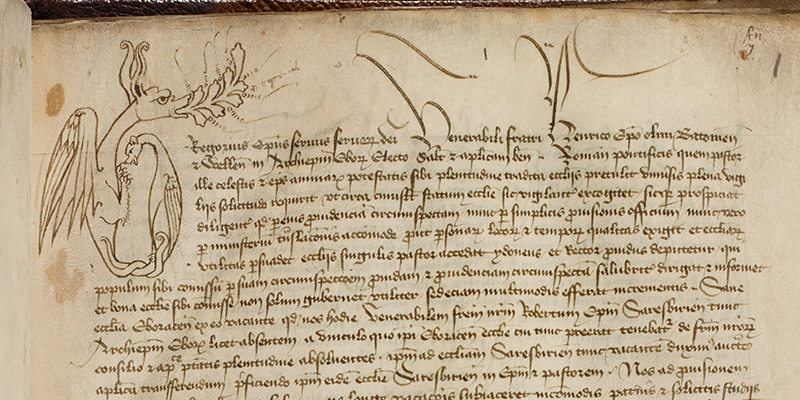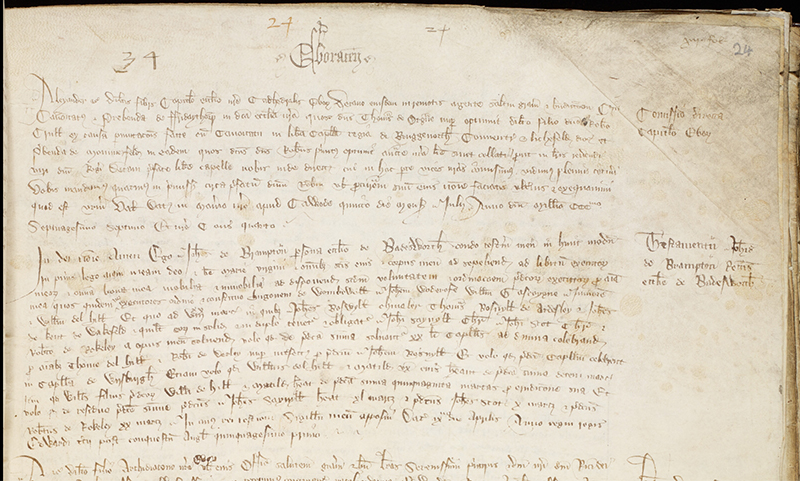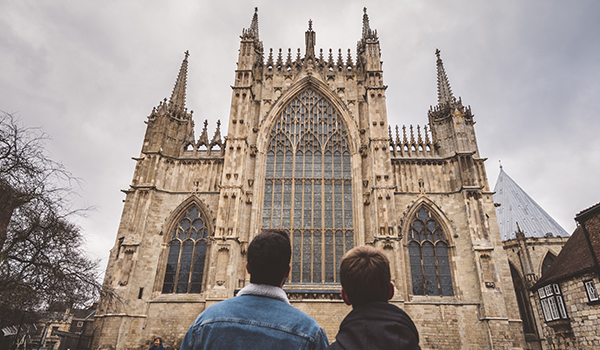
The Registers of the Archbishops of York
The surviving registers of the Archbishops of York, dating from between 1225 and around 1650, are held in the University of York’s Borthwick Institute for Archives.
Handwritten in ink, mostly on parchment, they have now been digitised and are freely available to view online. The resulting high-quality images are contained in a database which allows details to be added to all entries in the registers.
Books and rolls
Some of these registers exist in roll format, such as that of Walter de Gray, Archbishop from 1215 to 1255. This register is the first in the series (Reg 1), consisting of two parchment rolls, and was printed in The Register, or Rolls, of Walter Gray, Lord Archbishop of York: with Appendices of Illustrative Documents, ed. J. Raine, Surtees Society 56 (1872).
A thoroughly-revised edition is currently being made for future publication, together with further detailed research, by Dr Sethina Watson, Senior Lecturer in Medieval History, University of York, and Dr Maureen Jurkowski.
Other registers exist in book format, like the register of William Melton, Archbishop from 1317 to 1340, now divided between two volumes (Reg 9A and Reg 9B), with several sections already having been examined in the editions published by the Canterbury and York Society, whose work on this register is ongoing (see the Reading List below).
Church and state
Other entries show the ways in which church and state interacted, particularly in taxation of the clergy, which was carried out separately from taxation of lay people until the mid-seventeenth century. For instance, one entry concerns collection of the tax of two tenths on clerical property granted to Richard II by the clergy of York Province in 1378 (Reg 12, f. 25v).Whatever the format, all the registers record the various types of business performed by the Archbishop or his officials in the province and diocese of York and the areas covered by these ecclesiastical administrative units will be described in the next blog post.

Many entries found in the registers consist of copies of documents issued in the name of the Archbishop or received by him, including those, for instance, which highlight relations with the monarchy. Among these documents are significations of excommunication, that is, requests for assistance from the king in some cases where individuals had fallen foul of ecclesiastical law. The originals, consisting of the Archbishop’s ‘out letters’, may often be found among documents held in The National Archives (TNA), Kew, and series of records such as these will also be discussed in a forthcoming blog post. Other types of document concerning the monarchy might simply comprise prayers for the success of the king’s actions, particularly in wartime. One such entry is found in the register of Alexander Neville, Archbishop, 1374 to 1388, containing prayers for Edward III in 1377 during the Hundred Years War with France (Reg 12, f. 24r).
Details of corresponding documents surviving in the archive of the royal Exchequer are available on TNA’s website in the E 179 Database; in this case, only one associated document exists, a schedule of defaulters (E 179/63/8). Depending on date, the registers also reflect interaction with the papacy, for instance in records of the various types of papal dispensation, such as those permitting couples to marry or remain married even though related in certain prohibited degrees. One such example from 1404 is a dispensation for John Plompton and his wife Alice Gyllyng, for having married when they had a great-grandfather in common (Reg 16, f. 127).
Regional jurisdictions
The registers also record the business of the Archbishop in the various areas under his jurisdiction. They included the five archdeaconries of Cleveland, the East Riding, Nottingham, Richmond and York, as well as peculiars, including Hexham in Northumberland and diocese of Durham, and Churchdown in Gloucester in the medieval diocese of Worcester; so called because of the Archbishop’s personal jurisdiction over them even though located in other dioceses.
Such business would often include visitations or periodical inspections of the clergy, lay people or religious houses, following which correction of behaviour would be ordered. A very large proportion of entries in the registers relate to the clergy, and include records of their ordinations, for instance, into the priesthood; their institutions to benefices and inductions, that is, being given responsibility for both the care of the spiritual lives of their parishioners and of their church lands and possessions; also commissions to perform offices on behalf of the Archbishop. The registers also record many wills, their probate and details relating to the administration of estates of those dying without having made a will, both of clergy and lay people.
Improving access
Whatever the contents of the registers, in the past various factors may have led their contents to have been considered only approachable by specialists in ecclesiastical history, perhaps because they are not easy to read without some experience. Similar to most medieval ecclesiastical documents, the register entries are mainly written in Latin, with many words abbreviated, although some entries are in French or English. Many technical terms are used, requiring knowledge, for example, of such procedures as acts for the confirmation of the election of a bishop or the head of a religious house. However, because many entries are formulaic, they may become more easily understood with help from items in the Reading List below, including the chapter in the volume in honour of Emeritus Professor Mark Ormrod, who founded the original project to work on the registers.
Other aspects of the registers may also be problematic, such as the way in which they were put together. Although many registers are divided into sections for different types of business, some are not, and one in particular has been described by David Smith in his Guide to Bishops’ Registers as a confused mass (p. 243). This is the register of Archbishop John Kempe, covering the period 1426-1452 (Reg 19), and although the Guide gives details of the contents, it would need thorough examination to make complete sense of them. This is exactly what ‘The Northern Way’ Project hopes to achieve in its work on the registers for the fourteenth century, so watch this space!
- C. J. Offer, The Bishop’s Register (London, 1929)
- A. Hamilton Thompson, ‘The Registers of the Archbishops of York’, Yorkshire Archaeological Journal 32 (1936), 245-6
- J. S. Purvis, An Introduction to Ecclesiastical Records (London, 1953)
- D. M. Owen, The Records of the Established Church in England, British Records Association, Archives and the User, No. 1 (British Records Association, 1970)
- D. Robinson, ‘Bishops’ Registers’, in Short Guides to Records, 2nd series: Guides 25-48, ed. K. M. Thompson, The Historical Association (London, 1997), pp. 44-49
- D. M. Smith, A Guide to Bishops’ Registers in England and Wales: a Survey from the Middle Ages to the Abolition of the Episcopacy in 1646, Royal Historical Society, Guides and Handbooks series, 11 (London, 1981) and Supplement to the ‘Guide to Bishops’ Registers…, CYS (York, 2004)
- H. Watt, ‘Archbishops’ Registers Revealed: Church, State and Society in the Registers of the Archbishops of York, 1225-c.1650’, in ed. C. Taylor and G. Dodd, Monarchy, State and Political Culture in Late Medieval England: Essays in Honour of W. Mark Ormrod (forthcoming)
- The Register of William Melton, Archbishop of York, 1317–1340, volume I, ed. R. M. T. Hill, CYS, 70 (1977), (ff. 555-621)
- The Register of William Melton, Archbishop of York, 1317–1340, volume II, ed. D. B. Robinson, CYS 71 (1978) (ff. 269-320v)
- The Register of William Melton, Archbishop of York, 1317–1340, volume III, ed. R. M. T. Hill, CYS, 76 (1988) (ff. 622–688v)
- The Register of William Melton, Archbishop of York, 1317–1340, volume IV, ed. R. Brocklesby, CYS, 85 (1997) (ff. 400–477)
- The Register of William Melton, Archbishop of York, 1317–1340, volume V, ed. T. C. B. Timmins, CYS, 93 (2002) (ff. 83–151)
- The Register of William Melton, Archbishop of York, 1317–1340, volume VI, ed. D. B. Robinson, CYS, 101 (2011) (ff. 321-399).
Find out more about the medieval Archbishops of York
